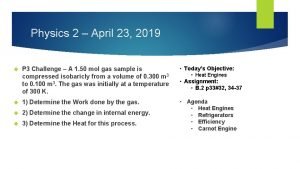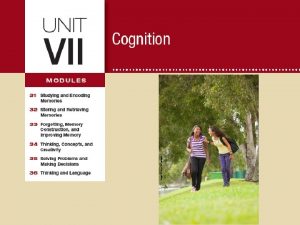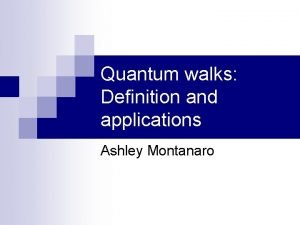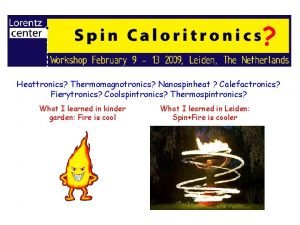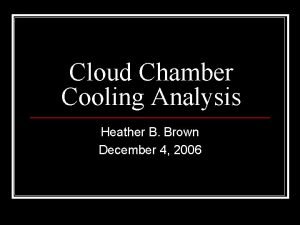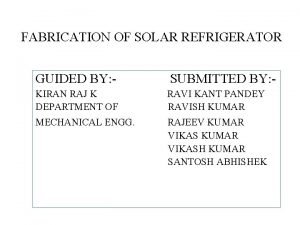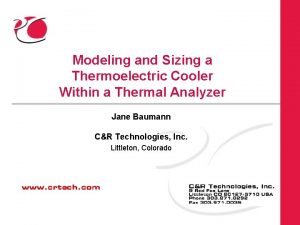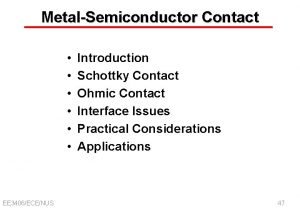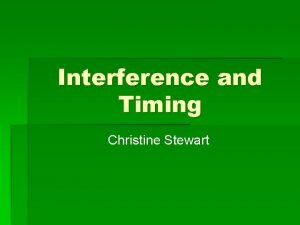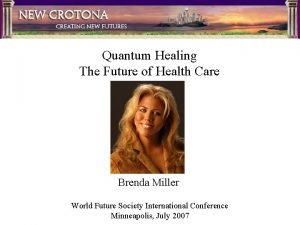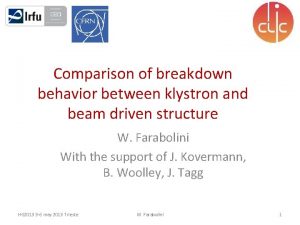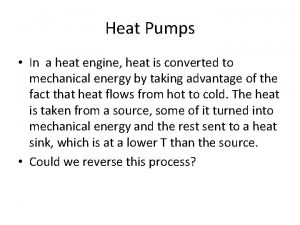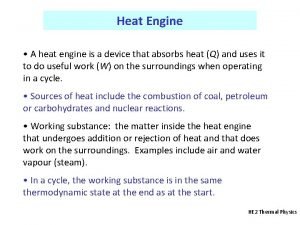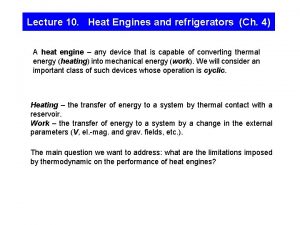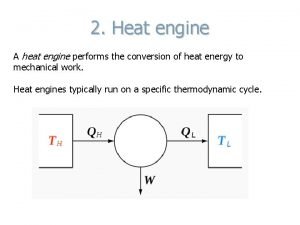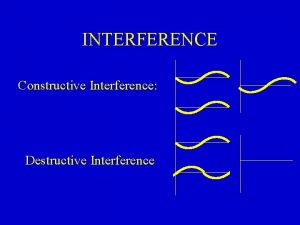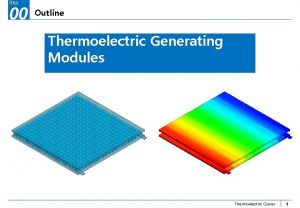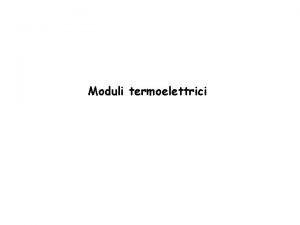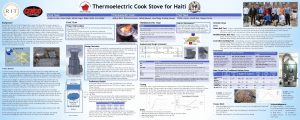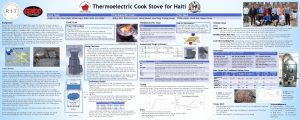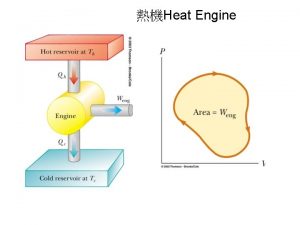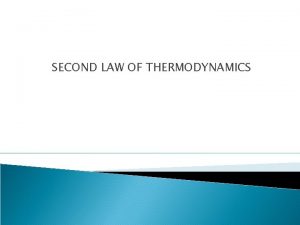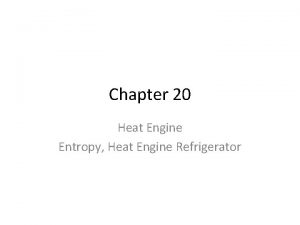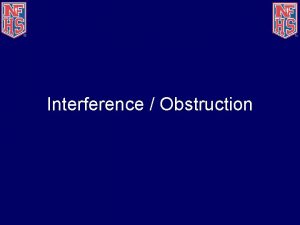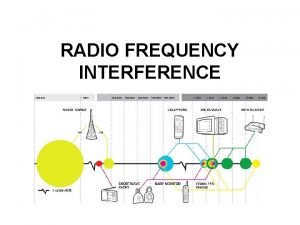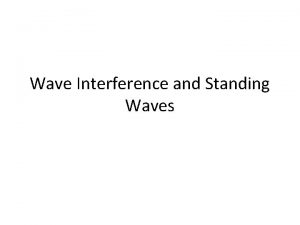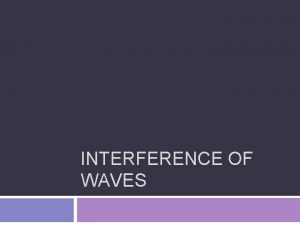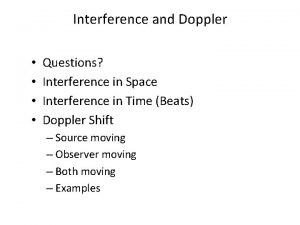Optimal quantum interference thermoelectric heat engine with edge




















- Slides: 20

Optimal quantum interference thermoelectric heat engine with edge states Peter Samuelsson, Sara Kheradsoud, Björn Sothmann APCTP-KIAS Workshop on Motors and Engines June 2018 P. Samuelsson, S. Kheradsoud, B. Sothmann, Phys. Rev. Lett. 118 , 256801 (2017).

Outline Thermoelectrics and edge state transport § Heat to electric energy conversion § Mesoscopic and nanoscale thermoelectrics § Edge state thermoelectrics Coherent thermoelectrics § Coherence enhanced performance. § Optimal performance. § Double-slit interferometer. Close-to-optimal edge state implementation § Mach Zehnder interferometer with side-coupled dot. § Transmission properties, power and efficiency. § Close-to-optimal performance.

Outline Thermoelectrics and edge state transport § Heat to electric energy conversion § Mesoscopic and nanoscale thermoelectrics § Edge state thermoelectrics Coherent thermoelectrics § Coherence enhanced performance. § Optimal performance. § Double-slit interferometer. Close-to-optimal edge state implementation § Mach Zehnder interferometer with side-coupled dot. § Transmission properties, power and efficiency. § Close to optimal performance.

Heat to electric energy conversion Thermoelectric heat engine Grand idea: Conversion of waste heat to electric energy Figure of merit Semiconductor thermocouple Heremans et al. , Nat. Nano. 2013 Going nano Hicks, Dresselhaus, PRB 1993 • Low dimensionality • Size quantization Strongly energy dependent transport

Nanoscale thermoelectric heat engines Multi terminal heat engines Roche et al. , Nat. Comm. 2015 Properties § Separated heat and electric current flows § Rectification of fluctuations Thierschmann et al. , Nat. Nano. 2015

Edge state thermoelectrics Edge state transport, integer quantum Hall effect Classical Three terminal heat engine Sanchez, Sothmann, Jordan, PRL 2015 Quantum Nernst effect Sothmann, Sanchez, Jordan, EPL 2014

Outline Thermoelectrics and edge state transport § Heat to electric energy conversion § Mesoscopic and nanoscale thermoelectrics § Edge state thermoelectrics Coherent thermoelectrics § Coherence enhanced performance. § Optimal performance. § Double-slit interferometer. Close-to-optimal edge state implementation § Mach Zehnder interferometer with side-coupled dot. § Transmission properties, power and efficiency. § Close-to-optimal performance.

Coherence enhanced performance Quantum dots/molecules Mach-Zehnder interferometer Rolleau et al. PRL 2008 Transport through twolevel system Karlström et al, PRB 2011 Bergfield, Stafford, Nano Lett. 2009 Heat engine proposal Hofer, Sothmann, PRB 2015

Optimal performance Optimal transmission properties Maximizing output power § Step function in energy Efficiency § At maximum power § Curzon-Ahlborn limited Whitney, PRL 2014 Q 1: Can a purely interference based TE-heat engine be optimal?

Double slit interferometer Generic interferometer Scattering amplitude Phase due to Aharanov-Bohm, . . No individual TE-effect Energy independent Scattering probability Energy dependence

Double slit interferometer Conditions for optimal performance § Symmetric interferometer, § Sharp phase jump . for Q 1: Can a purely interference based TE-heat engine be optimal? A 1: Yes Q 2: Is there a possible experimental realization of such optimal engine (with edge states)?

Outline Thermoelectrics and edge state transport § Heat to electric energy conversion § Mesoscopic and nanoscale thermoelectrics § Edge state thermoelectrics Coherent thermoelectrics § Coherence enhanced performance. § Optimal performance. § Double-slit interferometer. Close-to-optimal edge state implementation § Mach Zehnder interferometer with side-coupled dot. § Transmission properties, power and efficiency. § Close to optimal performance.

Mach-Zehnder with capacitor Properties § Quantum point contacts § Mesoscopic capacitor § Contacts § Interferometer Total transmission amplitude Scattering phase at MC

Transmission properties Semitransparent splitters (symmetric condition), Effective phase shift for

Transmission properties § Phase dependent symmetries § Filter analogy, , Ripple Transition width, roll-off

Thermoelectric scattering theory Linear response theory (non-interacting), charge and heat currents Butcher, 1990 Thermodynamic forces where Onsager matrix where

Power and efficiency Maximum power generated, with respect to voltage Efficiency at maximum power

Close-to-optimal performance Optimal, single mode performance (step function transmission) for Numerical optimization Optimizing over § Parameters § Values 90% 83%

Show-stoppers? Dephasing Asymmetry § Survives for moderate dephasing strength § Zero for complete dephasing. § Not very sensitive to arm length asymmetry

Conclusions § Interference-only thermoelectrics potentially optimal § Close-to-optimal performance in edge-state setup § Not very sensitive to dephasing and asymmetry P. Samuelsson, S. Kheradsoud, B. Sothmann, Phys. Rev. Lett. In press.
 Quantum heat engine
Quantum heat engine Proactive vs retroactive interference
Proactive vs retroactive interference Proactive and retroactive interference
Proactive and retroactive interference Ashley montanaro
Ashley montanaro Heattronics
Heattronics Thermoelectric cloud chamber
Thermoelectric cloud chamber Submitted by and guided by
Submitted by and guided by Melcor tec
Melcor tec Shottky contact
Shottky contact Non interference engine
Non interference engine Quantum physics vs mechanics
Quantum physics vs mechanics Quantum physics vs mechanics
Quantum physics vs mechanics Quantum edge healing institute
Quantum edge healing institute Rising edge and falling edge
Rising edge and falling edge External vs internal combustion engine
External vs internal combustion engine Brunsdon pumps
Brunsdon pumps A heat engine is a device that uses
A heat engine is a device that uses Difference between heat engine and refrigerator
Difference between heat engine and refrigerator Heat engine
Heat engine Dry cooking methods
Dry cooking methods Specific heat capacity
Specific heat capacity
